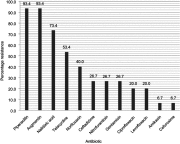Community acquired urinary tract infections among adults in Accra, Ghana
- PMID: 31372013
- PMCID: PMC6628945
- DOI: 10.2147/IDR.S204880
Community acquired urinary tract infections among adults in Accra, Ghana
Abstract
Background: Urinary tract infection (UTI) is one of the most common bacterial infectious diseases encountered in clinical practice, and accounts for significant morbidity and high medical costs. To reduce its public health burden, there is the need for local research data to address aspects of prevention and management of UTI. The aim of this study was to investigate community-acquired UTI among adults in Accra, Ghana, including the risk factors, etiological agents, and antibiotic resistance. Methods: This was a cross-sectional study involving 307 patients clinically diagnosed with UTI at the Korle Bu and Mamprobi polyclinics in Accra. Urine specimens were collected from the study participants and analyzed by culture, microscopy, and dipstick. The bacterial isolates were identified using standard microbiological methods and tested against a spectrum of antibiotics by the Kirby Bauer method. Multidrug resistant Enterobacteriaceae isolates were screened for Extended Spectrum β-lactamase (ESBL) production by the double disc method, and isolates that tested positive were analyzed by Polymerase Chain Reaction for ESBL genes. Demographic information and clinical history of study participants were collected. Results: Based on the criteria for laboratory confirmed UTI, 31 (10.1%) of the 307 specimens were positive and the main risk factor of UTI among the study participants was pregnancy (P=0.02, OR=2.43). The most common uropathogen isolated was Escherichia coli (48.9%), followed by Klebseilla sp. (16.1%). Prevalence of resistance was highest for Piperacillin (87.1%) and Amoxicillin+Clavulanic Acid (87.1%) and lowest for Amikacin (12.9%). Prevalence of multidrug resistance among the uropathogens was 80.1% (25) and the most common ESBL gene detected was CTX-M-15. Conclusion: Pregnant women constitute the key risk population of UTI in Accra, while Amikacin remains a suitable drug for the treatment of febrile UTI. The high prevalence of multidrug resistance among the uropathogens highlights the need for surveillance of antimicrobial resistance among these pathogens.
Keywords: extended spectrum β-lactamases; multidrug resistance; urinary tract infection.
Conflict of interest statement
The authors report no conflicts of interest in this work.
Figures
References
-
- Puca E. Urinary Tract Infection in Adults. Clin Microbiol Open Access. 2014;3(6). doi: 10.4172/2327-5073.1000e120 - DOI
-
- Gales AC, Jones RN, Gordon KA, et al. Activity and spectrum of 22 antimicrobial agents tested against urinary tract infection pathogens in hospitalized patients in Latin America: report from the second year of the SENTRY antimicrobial surveillance program (1998). J Antimicrob Chemother. 2000;45(3):295–303. doi: 10.1093/jac/45.3.295 - DOI - PubMed
-
- Shalini Maya A, Prabhakar K, Lakshmi Sarayu Y. A Study on prevalence and evaluation of clinical isolates from community acquired infections using different media in semiurban areas. World J Med Sci. 2010;5(2):49–53.
LinkOut - more resources
Full Text Sources


